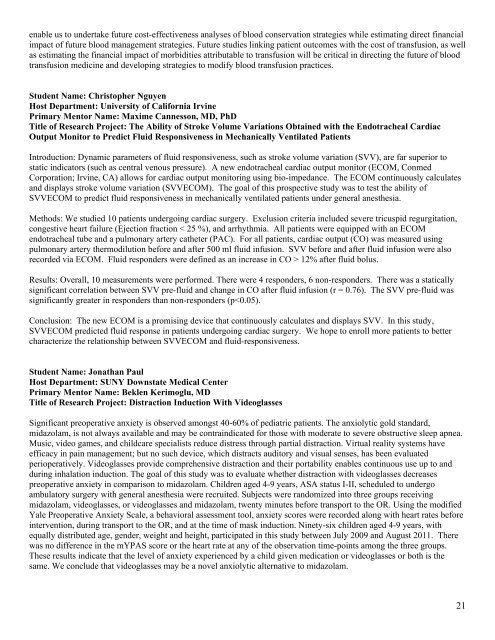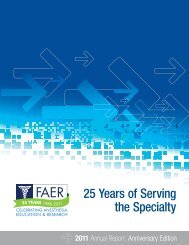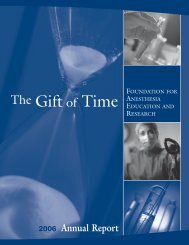2010 MSARF Symposium Participants - Foundation for Anesthesia ...
2010 MSARF Symposium Participants - Foundation for Anesthesia ...
2010 MSARF Symposium Participants - Foundation for Anesthesia ...
You also want an ePaper? Increase the reach of your titles
YUMPU automatically turns print PDFs into web optimized ePapers that Google loves.
enable us to undertake future cost-effectiveness analyses of blood conservation strategies while estimating direct financial<br />
impact of future blood management strategies. Future studies linking patient outcomes with the cost of transfusion, as well<br />
as estimating the financial impact of morbidities attributable to transfusion will be critical in directing the future of blood<br />
transfusion medicine and developing strategies to modify blood transfusion practices.<br />
Student Name: Christopher Nguyen<br />
Host Department: University of Cali<strong>for</strong>nia Irvine<br />
Primary Mentor Name: Maxime Cannesson, MD, PhD<br />
Title of Research Project: The Ability of Stroke Volume Variations Obtained with the Endotracheal Cardiac<br />
Output Monitor to Predict Fluid Responsiveness in Mechanically Ventilated Patients<br />
Introduction: Dynamic parameters of fluid responsiveness, such as stroke volume variation (SVV), are far superior to<br />
static indicators (such as central venous pressure). A new endotracheal cardiac output monitor (ECOM, Conmed<br />
Corporation; Irvine, CA) allows <strong>for</strong> cardiac output monitoring using bio-impedance. The ECOM continuously calculates<br />
and displays stroke volume variation (SVVECOM). The goal of this prospective study was to test the ability of<br />
SVVECOM to predict fluid responsiveness in mechanically ventilated patients under general anesthesia.<br />
Methods: We studied 10 patients undergoing cardiac surgery. Exclusion criteria included severe tricuspid regurgitation,<br />
congestive heart failure (Ejection fraction < 25 %), and arrhythmia. All patients were equipped with an ECOM<br />
endotracheal tube and a pulmonary artery catheter (PAC). For all patients, cardiac output (CO) was measured using<br />
pulmonary artery thermodilution be<strong>for</strong>e and after 500 ml fluid infusion. SVV be<strong>for</strong>e and after fluid infusion were also<br />
recorded via ECOM. Fluid responders were defined as an increase in CO > 12% after fluid bolus.<br />
Results: Overall, 10 measurements were per<strong>for</strong>med. There were 4 responders, 6 non-responders. There was a statically<br />
significant correlation between SVV pre-fluid and change in CO after fluid infusion (r = 0.76). The SVV pre-fluid was<br />
significantly greater in responders than non-responders (p





